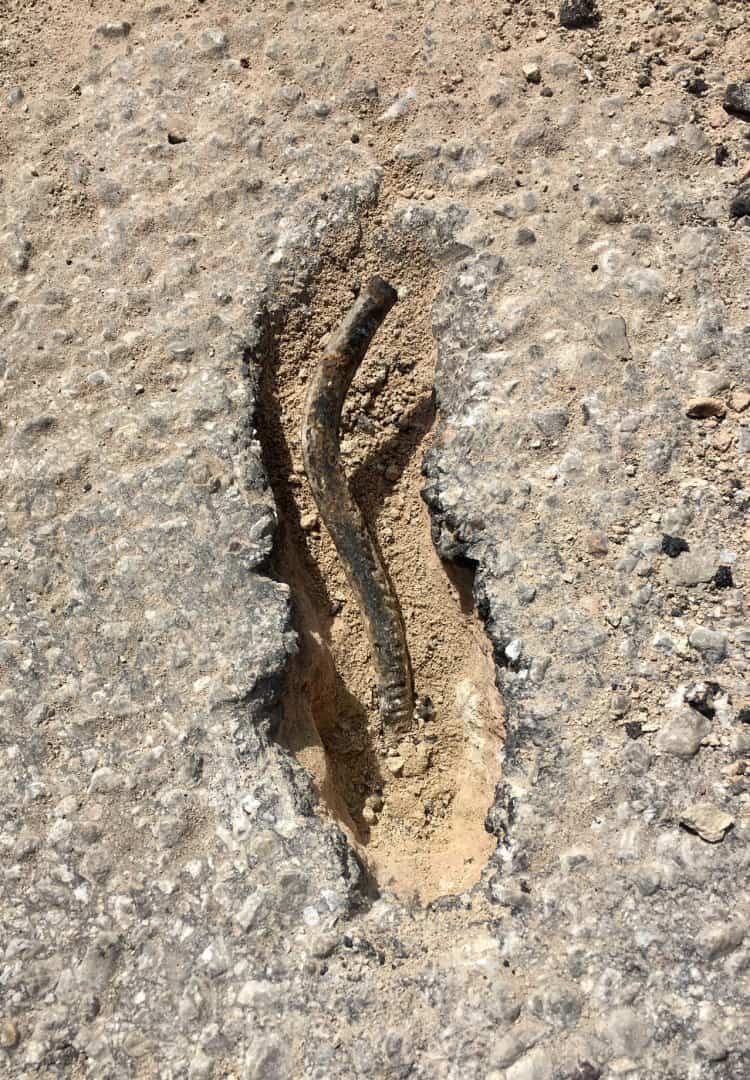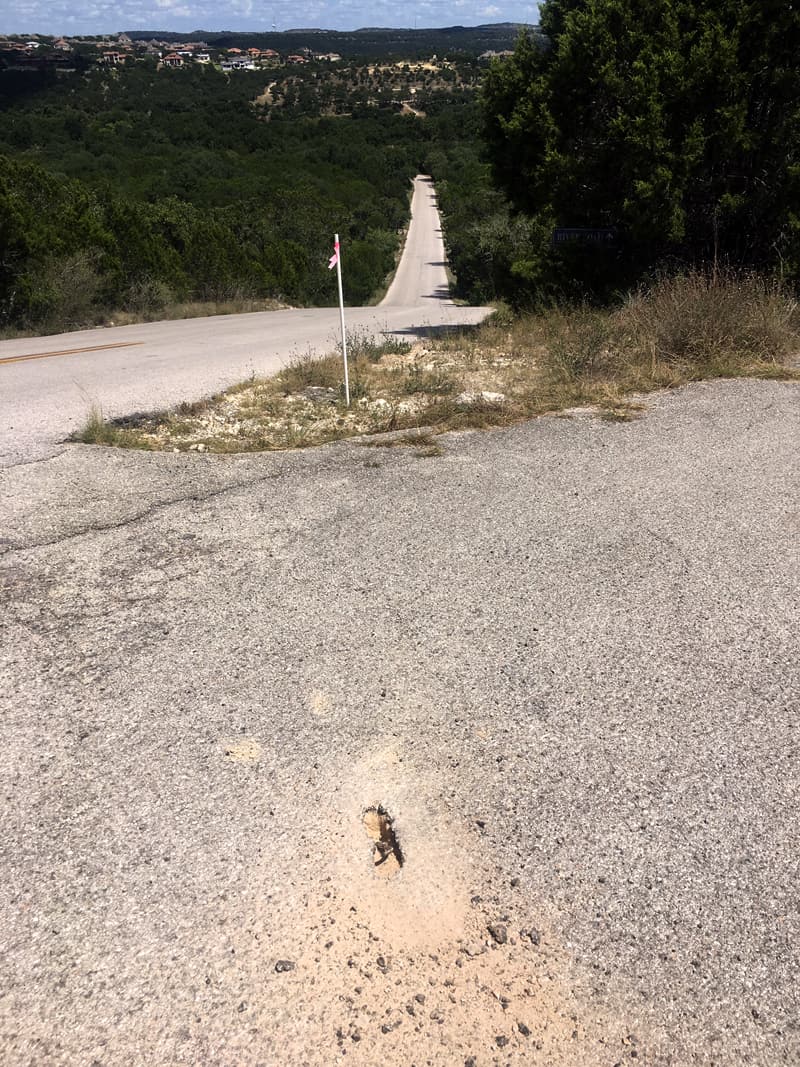Ordinarily, it is not good news to find a boundary marker that a road grader has turned into a steel pretzel. But I was thrilled to find this one after wading through the hot end of the afternoon looking in all of the places where a local surveyor had noted in 1962 that he'd "set steel stake" and finding no steel stakes in place in areas that otherwise appeared to be undisturbed cedar brake. The whole point of the exercise was to attempt to rectify a blunder that he had made in his work that otherwise casts where exactly he located the right-of-way of a county road into the Pit of Darkness.
So this steel pretzel was a welcome sight, even if was an adventure in metal detecting to pick up one end of the thing and then chase it back to its base that remained firmly set in the native caliche and road base. Light work to extract, straighten and reset in the position of the plumb base.
Voila! June 22, 1962 is reborn July 26, 2017, fifty-five years later.
NB: the one advantage to the heat is that you can scavenge bits of asphalt pavement from the edges of a roadway and recycle them as patches for incisions in the pavement elsewhere. The asphalt was hot enough that it was easy to compact it to fill the scar.
See here, Watson, there really is a pretzel.................The game is afoot.............
Kent,
I like the fact that you repaired the bar.
But just to yank your chain a bit....I must comment that your Texas asphalt looks to be rather deficient in quantity.
John Evers, post: 438814, member: 467 wrote: I must comment that your Texas asphalt looks to be rather deficient in quantity.
That asphalt is the standard rural county road pavement of two-course surface treatment, i.e. prime coat on finished road base surface, binder coat with gravel on it, and finished off with seal coat. You're probably looking at a couple of iterations of surface treatment where I made that incision. It was thin and easy to cut with a mason's hammer.
Kent McMillan, post: 438818, member: 3 wrote: That asphalt is the standard rural county road pavement of two-course surface treatment, i.e. prime coat on finished road base surface, binder coat with gravel on it, and finished off with seal coat. You're probably looking at a couple of iterations of surface treatment where I made that incision. It was thin and easy to cut with a mason's hammer.
In PLSSia we would call that a double bituminous surface or just "dubble-bit". Single bituminous treatment is usually referred to as "oil and chip" here in the rectangular states. What I see there is merely aggregate and tar flying in close formation
You refer to it as 'asphalt pavement' which is not quite technically correct. While it does utilize asphaltic cement (AC) as a binder it is actually merely a surface treatment, not true full depth ACP, better known as asphaltic concrete pavement. ACP being a hot-mixed product of AC and graded aggregate placed in lifts and delicately compacted during cooling to provide a specified density. That end result is a durable load bearing concrete, not merely a smelly and sticky short-lived waterproofing.
I would think one that can drag out a dozen posts on the age and markings of a piece of reinforcing bar would have a little more expanded knowledge of the material in which that re-bar was driven. 😉
paden cash, post: 438828, member: 20 wrote: In PLSSia we would call that a double bituminous surface or just "dubble-bit". Single bituminous treatment is usually referred to as "oil and chip" here in the rectangular states. What I see there is merely aggregate and tar flying in close formation
You refer to it as 'asphalt pavement' which is not quite technically correct. While it does utilize asphaltic cement (AC) as a binder it is actually merely a surface treatment, not true full depth ACP, better known as asphaltic concrete pavement. ACP being a hot-mixed product of AC and graded aggregate placed in lifts and delicately compacted during cooling to provide a specified density. That end result is a durable load bearing concrete, not merely a smelly and sticky short-lived waterproofing.
I would think one that can drag out a dozen posts on the age and markings of a piece of reinforcing bar would have a little more expanded knowledge of the material in which that re-bar was driven.
If this pavement were in Oklahoma, I'm sure you might have a point, but in Texas the specifications of the TEXAS HIGHWAY DEPARTMENT were in common usage in 1962 when that rebar was set and as far as those specifications are concerned, Pavement and Surface Treatment are synonymous and distinct from Road Base.
While I would not doubt that above the Red River just spreading anything other than sand or clay over the roadbed might qualify as "paving", in Texas the term denotes a more permanent, all-weather surface such as an asphaltic surface treatment, or even concrete, provides.
Kent McMillan, post: 438829, member: 3 wrote: If this pavement were in Oklahoma, I'm sure you might have a point, but in Texas the specifications of the TEXAS HIGHWAY DEPARTMENT were in common usage in 1962 when that rebar was set and as far as those specifications are concerned, Pavement and Surface Treatment are synonymous and distinct from Road Base.
While I would not doubt that above the Red River just spreading anything other than sand or clay over the roadbed might qualify as "paving", in Texas the term denotes a more permanent, all-weather surface such as an asphaltic surface treatment, or even concrete, provides.
I apologize for not recognizing the roadway as a State Highway route; it appeared to me to be a county maintained road.
paden cash, post: 438837, member: 20 wrote: I apologize for not recognizing the roadway as a State Highway route; it appeared to me to be a county maintained road.
The Texas Highway Department specifications have been widely used in Texas since road contractors should be familiar with them.
paden cash, post: 438828, member: 20 wrote: Single bituminous treatment is usually referred to as "oil and chip" here in the rectangular states. 😉
Or as my father, county engineer, called it, "Pi$$ tar and throw rocks at it.":)






